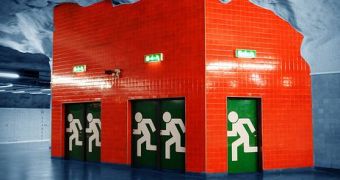A team of scientists, including a University of Michigan researcher, developed a disaster-response planning model that considers human decisions made in real-time, before establishing an effective law-enforcement strategy during evacuations.
The model they developed is for pedestrian traffic but could also be applied to vehicle traffic management.
Judy Jin, associate professor in the Department of Industrial and Operations Engineering and an author of a paper on the research, says that “when a disaster happens, people need to evacuate immediately, and it's difficult to plan for these situations.
“This new model could help government entities train first responders and determine the best policies to put in place to prepare for emergencies.”
The new simulation model can tell emergency planners how many police officers are necessary on the disaster scene to speed up the evacuation or how a certain percentage of tourists can slow it down.
In a desire to program the simulation after real human behavior, the team recorded human choices during a virtual reality experiment.
They had six volunteers who had to evacuate a simulated bomb explosion at the National Mall in Washington, DC, and the exercise was done three times.
The idea behind the experiment was to find out how people make decisions and also how do they plan them, in order to create a very complete and complex model.
People are constantly learning from the new information they are gathering, like whether there is a fire, smoke, the instructions coming from police officers and the way that the crowd acts.
The researchers knew that locals escape faster than tourists, because they are familiar with the area, and don't actually need any help from police officers or other people.
So to investigate how would the number of police officers or locals in a certain area affect evacuation times, the team ran simulations on 500 people, escaping from the National Mall after a bomb explosion.
As the number of policemen rose from 10 to 100, the evacuations time got 25% longer, but when the local residents' number increased from 10 to 200, the evacuation time shortened by 30 seconds (10%).
After gathering all this information about behaviors and reactions, the researchers built a model that considers the way that different types of people react in emergency situations.
Jin said that “these results would help officials decide on the optimal number of policy officers in various emergency situations, taking into consideration the percentage of tourists typically present in a city.”
This research was carried out as a part of the Multidisciplinary University Research Initiative project funded by the Air Force Office of Scientific Research, and Jin was the project team leader at the University of Michigan.
The paper is titled "An integrated human decision making model for evacuation scenarios under a BDI framework," and is co-authored by Jin, doctoral student Seungho Lee and associate professor Young-Jun Son at the University of Arizona.
It will be published in the next edition of the quarterly ACM Transactions on Modeling and Computer Simulation.

 14 DAY TRIAL //
14 DAY TRIAL //